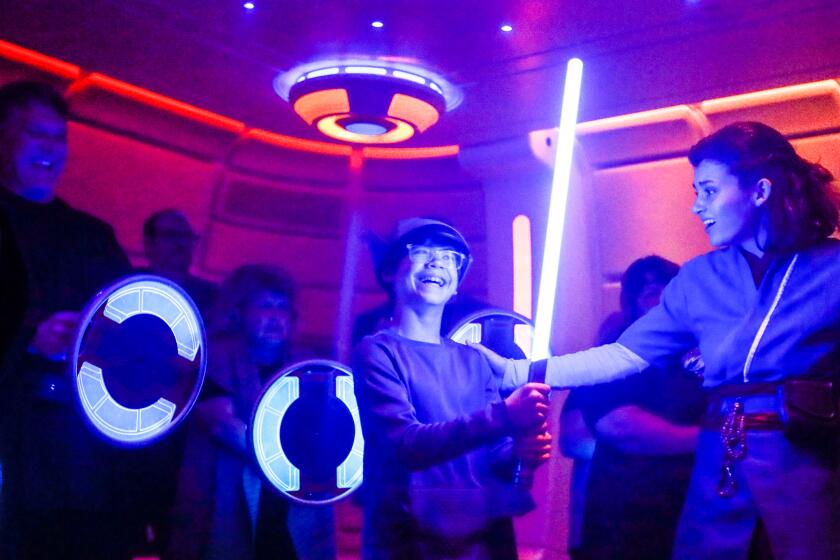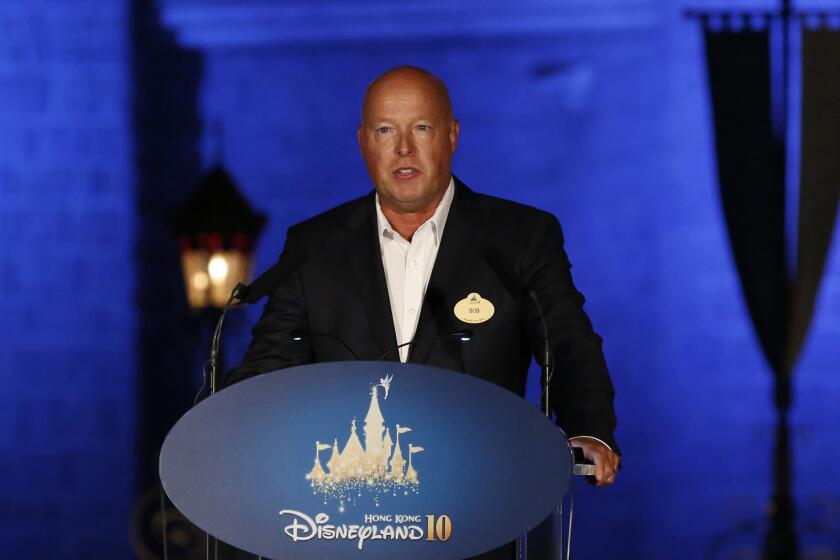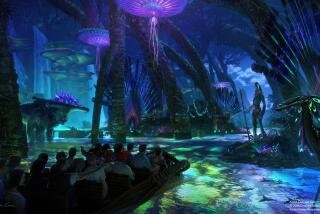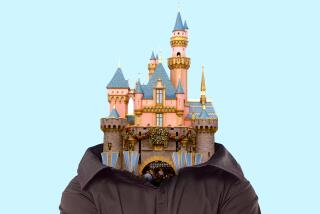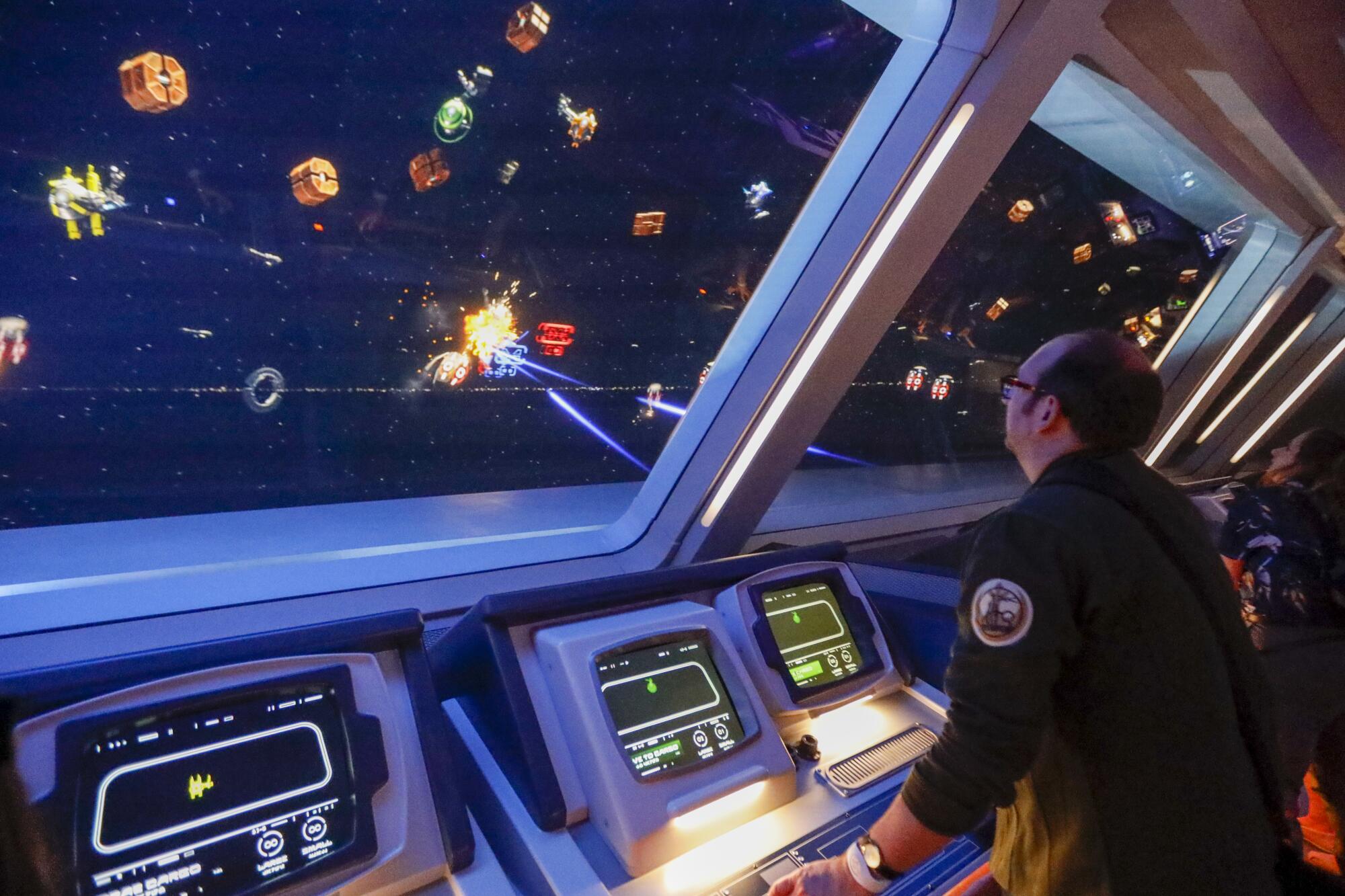
- Share via
Before Walt Disney World’s Star Wars: Galactic Starcruiser, there was chaos in Disneyland’s Frontierland.
The Galactic Starcruiser is an immersive, two-day, live-in theme park experience in which guests learn to wield a lightsaber and have one-on-one interactions with characters such as Captain Keevan and Sammie the engineer. Meanwhile, the short-lived Legends of Frontierland, which ran at Disneyland in the summer of 2014, had Coyote Chris, Willum and Red, among other Wild West characters.
It was one of Disney’s more notable LARPs — a live action role-playing game — and it helped inform the participatory experience that is the Galactic Starcruiser.
So while California’s Disney theme park fans must travel across the country to experience the pricey Galactic Starcruiser — a cabin for two starts at approximately $5,000 — Anaheim regulars over the years were some of the primary playtesters for what would become one of the company’s most activity-driven attractions. The Galactic Starcruiser, commonly referred to as the “‘Star Wars’ hotel,” is a full two-day LARP in which tourists are encouraged to follow multiple storylines. Think the immersive theater of New York’s “Sleep No More” or a full-scale, all-encompassing role-playing game, only stretched to 40-plus hours.
Legends of Frontierland attempted to transform the original Disney “land” into a game board of its own. It was one of a number of playtests that pulled on Disney’s large SoCal consumer base, with the goal of seeing how far Walt Disney Imagineering — the company’s arm devoted to theme park experiences — could push guests into game-inspired endeavors. It was a hit, so much so that it has essentially been re-imagined by Knott’s Berry Farm and continues to live as Ghost Town Alive, proving that mainstream audiences are, in fact, ready to LARP.
But if Legends of Frontierland was a successful playtest for the Imagineers, it left something to be desired as an experience, according to Scott Trowbridge, who led the teams that created the Galactic Starcruiser and the Disneyland and Walt Disney World land Star Wars: Galaxy’s Edge.
It may be the most ambitious Disney theme park endeavor since Disneyland: Star Wars: Galactic Starcruiser, a live-action role-playing game for the 1%.
The game of Legends of Frontierland was relatively vague. Guests tried to accrue little wooden tokens known as “bits,” which were used to buy land or bribe others. The goal was to be on the team with the most land. But multiple storylines and subplots developed. One could get thrown in jail or even purchase a Frontierland landmark such as the Golden Horseshoe.
In one sense, the game harked back to Frontierland’s beginning, before the park constructed Mine Train Through Nature’s Wonderland and its replacement, Big Thunder Mountain Railroad, when the land was largely populated with costumed Wild West “traders, trappers, cow hands, ‘two-gun men,’ dudes and dance hall girls,” as described in some of the park’s promotional descriptions of Frontierland from 1955.
For 21st century Imagineers, it provided a key lesson for the Galactic Starcruiser: no “bits.”
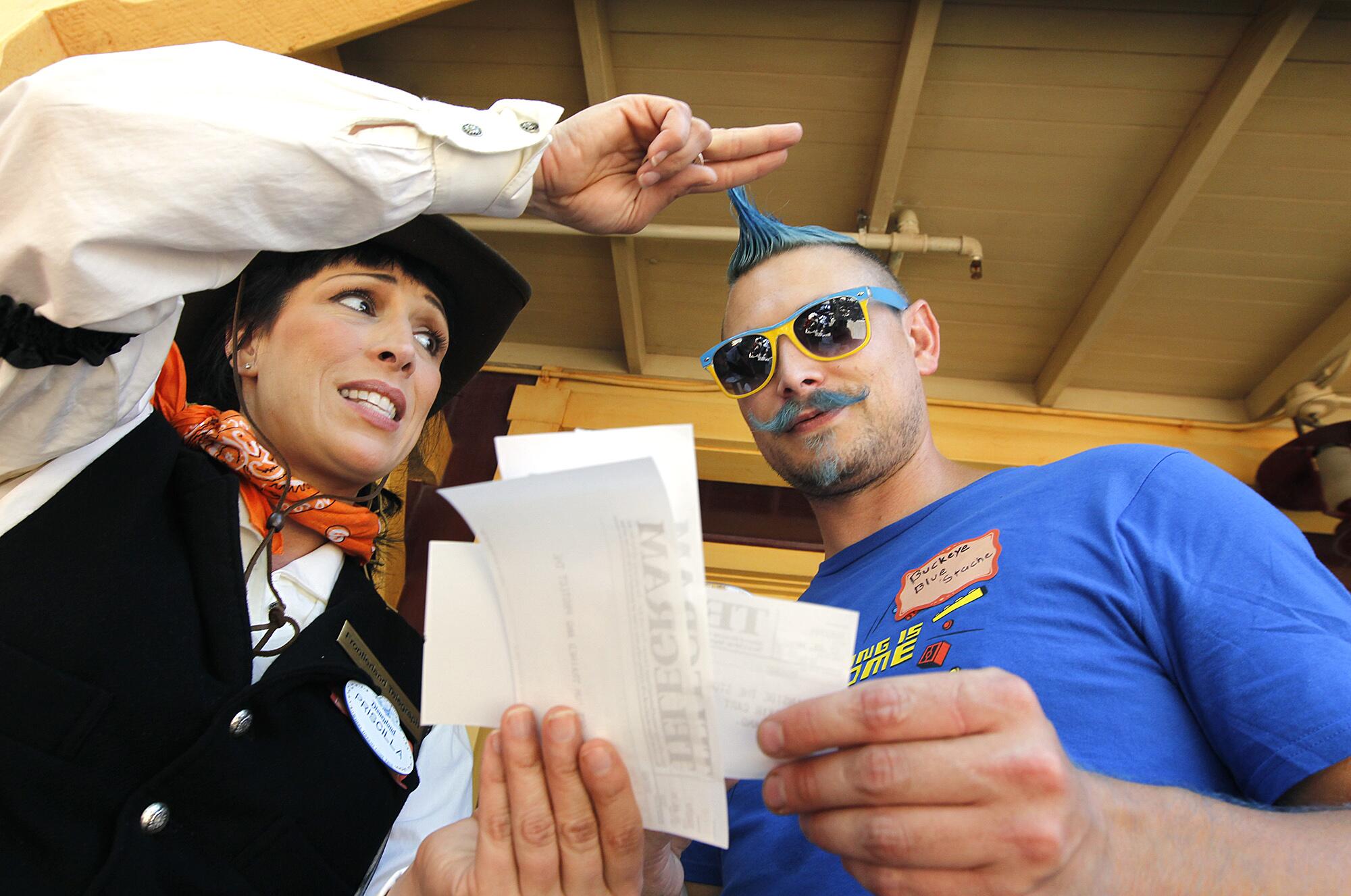
“It did not work as an experience,” Trowbridge says. Asked to expand, Trowbridge cites the lack of guardrails and says the idea of a fictional financial currency is not something that translates to a Disney park or resort. In short, it resulted in some guests having too much perceived power and the company constantly trying to reset the game.
“Lesson No. 1: In-game economies are hard,” Trowbridge says. “That was one thing we learned right away. It’s hard to balance. We built a little bit of game that was a territory back and forth, and we did not balance that game effectively enough. Hopefully that was invisible to our participants, but you want that rock to be balancing on top of the hill, and what we found was the rock kept rolling down the hill, and behind the scenes we had to keep pushing it up the hill.”
Disney’s Pride Advisory Group declined to endorse or condemn the walkout, organized by a group of Disney employees over CEO Bob Chapek’s response to Florida’s so-called “Don’t Say Gay” bill.
That led to a couple of key lessons for building the behind-the-scenes game of the Galactic Starcruiser. On one simple level, the Starcruiser relies heavily on the Play Disney Parks app, which helps give it the structure that Legends of Frontierland lacked. That’s because the app can create the perception of having conversations with the actors that populate the game, which in turn informs the improv that occurs. But Legends of Frontierland also led to some conceptual ideas that drive the Starcruiser, which, at its highest level, is about choosing a side between the good guys of the Resistance or the evil forces of the First Order.
“We changed the currency. In Legends of Frontierland, the currency was literally bits,” Trowbridge says. “In this [Starcruiser] experience, the currency is trust and information. What do you know? Do I trust it? That makes it sound super cynical, but I don’t think it is.”
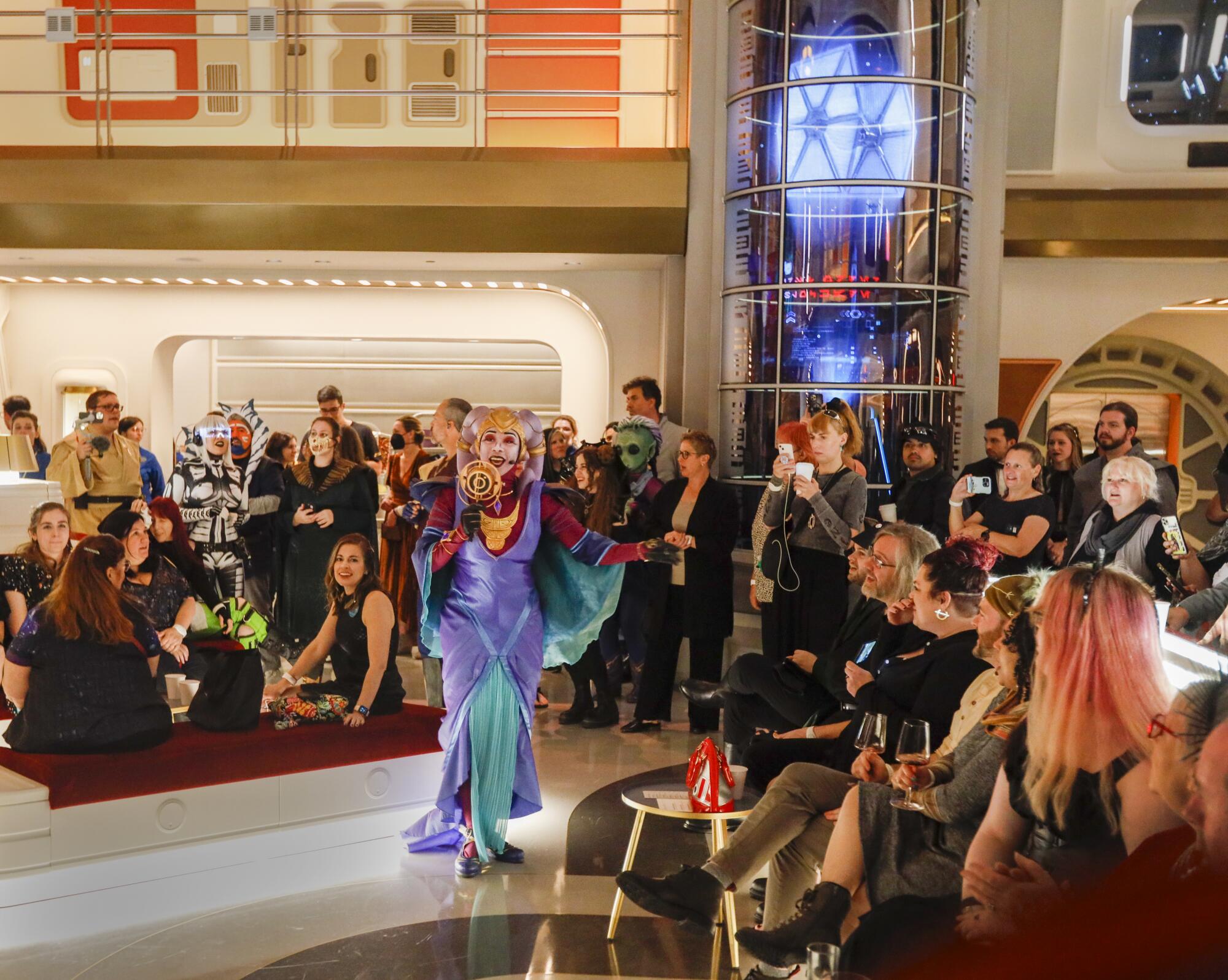
“It’s an experience about building relationships,” says Sara Thacher, one of the architects of the Galactic Starcruiser game.
What it means to switch the currency from bits to information is that players advance through the Galactic Starcruiser by learning. It’s curiosity and not the desire to amass fake money that is rewarded aboard the cruise-inspired experience.
Thacher jokes that she’s done more LARPs than cruises, and one of the lessons of the former — as well as Legends of Frontierland — is to ensure that the setting is impressive enough that guests will happily explore it. This, combined with the reliance on the Play Disney Parks app, can help avoid one of the hiccups in immersive theater, in which participants will crowd around an actor.
In other words, make sure the environment can handle some heavy lifting, so much so that players will want to simply hang in the lounge, for instance, and play a card game.
“That reason to be there means that amazing things are going to just wander in,” Thacher says. “I’m playing Sabacc in the lounge, and that gives me a reason to just dwell there and feel a part of the world. I can have my Han Solo moment and put all my chips in the center of the table. That’s not the big story, but it allows the big story to come and find me, rather than the other way around. That’s actually really important — those reasons to dwell and just be a part of the world.”
Before joining Imagineering, Thacher specialized in the creation of alternate reality games, perhaps most notably as the co-creator of the Jejune Institute, which inspired the AMC series “Dispatches From Elsewhere.” When she started eight years ago, the Galactic Starcruiser was still a few months away from its early conceptualization, but Thacher’s role from the beginning was to recognize that today’s guests are already playing in the Disney parks via fan meetups and themed days, and to see how much more attendees may be willing to participate.

“We were in the business of, ‘What are the experiences that can expand the palette of guest experiences?’” Thacher says. “How can we push on what the duration of those experiences can be? What types and ways can guests become involved, and how much more can they be part of the story? That was a big piece of why I came on board.”
Thacher developed two major guest-facing experiences that helped inform the Starcruiser. One was the alternate reality game attached to the 2015 film “Tomorrowland” that was called “The Optimist.” It tied into Disneyland and Walt Disney history and ran for a fixed six-week period. Another was the 2016 project Ghost Post, in which three puzzle boxes and one epilogue envelope would be sent to participants who bought in. It was limited to just 999 players.
The Ghost Post was integral, in that it utilized an app that could trigger reactions at Disneyland, but both were important in figuring out how fluid a game could be with time. An early lesson learned was that players needed to be able to enter at any moment in the story. Having something run purely on an “event-based nature,” Thacher says, can exclude people, since the narrative may move faster than they are playing.
The trick is to avoid something feeling like a “live radio broadcast” — that is, if they miss part of the story, then they are lost — and to ensure there is enough to do over 40-plus hours. The Ghost Post, for instance, took most players between 10 and 16 hours to complete, Thacher estimates, and that was without actors. Add in the lessons of the LARP that was Legends of Frontierland, and one starts to have the building blocks for the Starcruiser, where there are actors to interact with, card games to play, rooms to explore and ship controls that can be hacked.
“I will say that all of these experiences gave us the confidence of how much structure was necessary,” Thacher says. “We looked at each other throughout the development process and said, ‘How? We’re making a 45-hour experience! How much story is that?’ And we were making a 45-hour experience in which not everybody experiences the same thing. So having things in our back pocket, whether it’s Frontierland or the Ghost Post, was about starting to understand how much stuff we needed to build to have enough to do.”
It’s all further evidence that no matter what theme park experience is created, it will likely have roots that can be traced back to Disneyland.
Sit back and enjoy the ride? No more. From Disney’s new Star Wars: Rise of the Resistance to Japan’s upcoming “living video game” Super Nintendo World, theme-park audiences must participate to get the full experience.
More to Read
The biggest entertainment stories
Get our big stories about Hollywood, film, television, music, arts, culture and more right in your inbox as soon as they publish.
You may occasionally receive promotional content from the Los Angeles Times.
